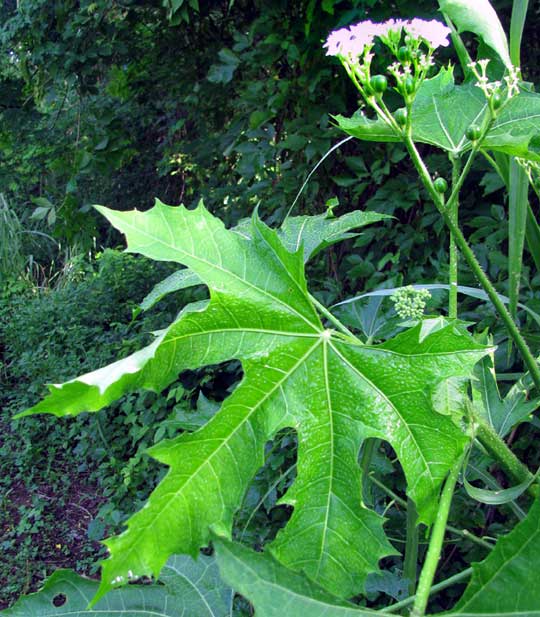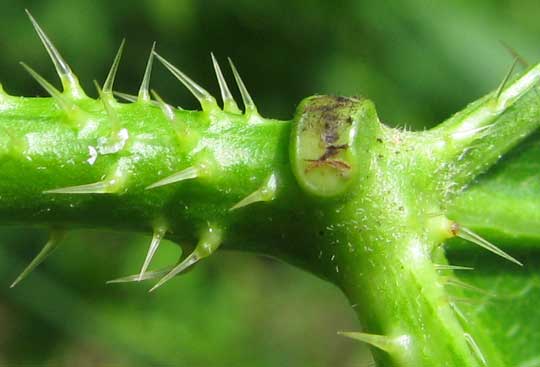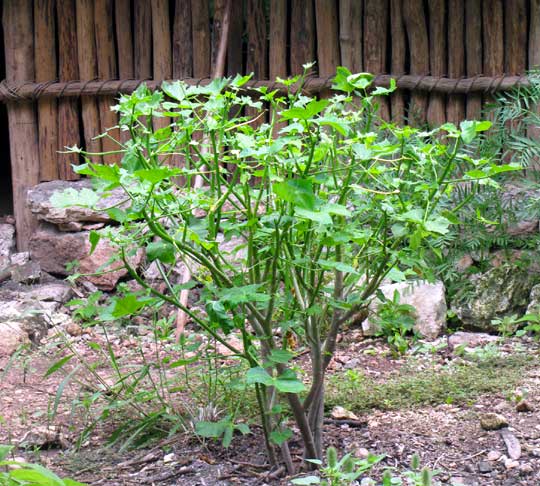Excerpts from Jim Conrad's
Naturalist Newsletter
from the August 1, 2010 Newsletter issued from Hacienda Chichen Resort beside Chichén Itzá Ruins, central Yucatán, MÉXICO; limestone bedrock, elevation ~39m (~128ft), ~N20.676°, ~W88.569°
MALA MUJER & CHAYA
During most of the year, at the edges of woods and along woodland trails, you commonly see the eight-ft-tall (±2.5 m) bushes (sometimes trees up to 20 feet tall, or 6 m) with deeply cut, hand-size leaves and long-stalked clusters of white flowers shown below:

In most of Mexico this is called Mala Mujer (mu-HER), which translates to "Bad Woman," because the plant abundantly bears long, sharp hairs that produce burning, nettle-like stings. The plant is CNIDOSCOLUS ACONITIFOLIUS, a member of the Spurge Family, the Euphorbiaceae, in which we also find Poinsettias, Castor Bean and Cassava or Manioc.
Knowing that Mala Mujer is in this family, we're not surprised when white latex oozes from its torn leaves. Flowers in that family are unisexual, but individual species may bear either both sexes on each plant (dioecious) or only one flower-gender per plant (monoecious). Mala Mujer flower clusters bear many male flowers plus a few female flowers (so they're monoecious) without petals, but with white calyx lobes looking like petals.

Above you see a male flower on the left, with stamens extending from the corolla tube. At the right the frilly item spreading umbrellalike above the flower's ovary is formed by three deeply-divided styles -- the ovary's three "necks" connecting pollen-receiving stigmatic areas with the ovary. In Mala Mujer plants female flowers are few but open first; male flowers are many, but only a few flower at any one time.
Mala Mujer's main claim to fame is its long, sharp, stinging spines, shown on a leaf petiole below:

In that picture also notice the big gland at the top of the petiole and at the base of the leaf blade. I saw ants visiting these glands, so if you're a big herbivore with lips so tough that stinging hairs don't bother you, maybe the ants will. Mala Mujers believe in stinging you one way or another.
There's a cultivated form of Mala Mujer known as Chaya. Chaya is one of the Mayas' most important plants, for it bears few or no stinging hairs, and its leaves are good to eat, very tasty and unbelievably nutritious. Chaya is richer in iron than spinach, and is very rich in potassium and calcium.
In fact, according to the National Institute of Nutrition in Mexico City, ingesting Chaya improves blood circulation, helps digestion, improves vision, soothes hemorrhoids, helps lower cholesterol, helps reduce weight, prevents coughs, augments calcium in the bones, decongests and disinfects the lungs, prevents anemia by replacing iron in the blood, improves memory and brain function and combats arthritis and diabetes. This and more info, plus a chart comparing Chaya with Alfalfa and Spinach is available here.
All visitors checking into Hacienda Chichen receive a class of cold Chaya sweetened with pineapple juice.
Not only are Chaya's leaves nutritional but the plants themselves are very easy to grow. Just machete off some branches, poke them in the ground, keep the soil around the stems moist, and the stems will root and begin growing. A couple of months ago Don Filomeno cut some stems which I planted beside my hut door. You can see the resulting fast-growing, waist-high shrub below:

In two months, despite having been completely defoliated by caterpillars a month ago, and being under attack by leafcutter ants now, the stems have doubled in size.
Though Mala Mujer and Chaya go by the same technical name, Cnidoscolus aconitifolius, besides the fact that Chaya has few or no stinging hairs, Chaya's leaves are much less deeply lobed than those of Mala Mujer, and the whole Chaya plant is less gangly looking than Mala Mujer-- more leafy and compact.